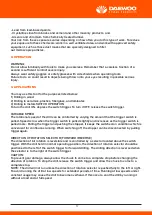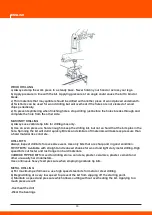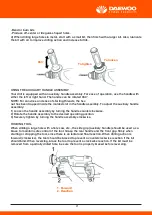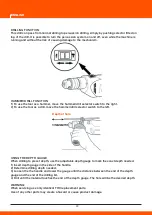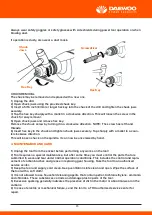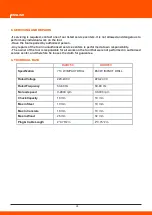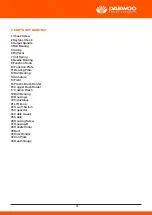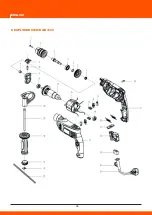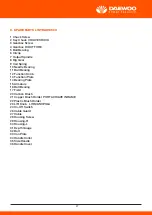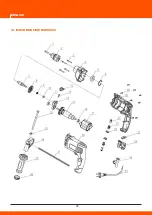
BOTÓN DE BLOQUEO
Este taladro está equipado con una característica de bloqueo, la cual para la perforación continua
durante periodos de tiempo prolongados.
Para bloquear:
1) Oprima el gatillo hasta el final.
2) Presione y mantenga presionado el botón del seguro de encendido, situado en el lado del mango.
3) Suelte el gatillo.
4) Soltar el botón del seguro de encendido y el taladro continuará funcionando.
5) Para liberar el bloqueo, apriete y suelte el gatillo del interruptor.
Si el seguro de encendido se activa durante el uso y el taladro se desconecta de la red eléctrica,
desconectar el seguro de encendido de inmediato.
PERFORACIÓN
1) Pulse y suelte el gatillo para asegurarse de que la perforación está en la posición de apagado
antes de conectarlo a la fuente de alimentación.
2) Compruebe el selector de sentido de rotación para el ajuste correcto (hacia delante o hacia atrás).
3) Asegurar el material a ser taladrado en un tornillo de banco o con mordazas para evitar que gire al
girar la broca.
4) Enchufe el taladro en la fuente de suministro de energía.
5) Sostenga firmemente el taladro y coloque la broca en el punto a taladrar.
6) Apriete el gatillo para encender el taladro. No bloquee el interruptor para trabajos donde puede
que sea necesario suspender repentinamente el taladro.
7) Mueva la broca en el trabajo aplicando solamente suficiente presión para mantener la broca. No
fuerce el taladro ni aplique presión lateral para alargar un agujero. Deje que el taladro y la mecha
hagan el trabajo.
ADVERTENCIA:
Esté preparado para la unión de la ruptura de la mecha. Cuando se producen estas situaciones, el
taladro tiende a atascarse y retroceder opuesta a la dirección de rotación y podría causar la pérdida de
control al cortar el material. Si no está preparado, esta pérdida de control podría ser causa de lesiones
graves.
a) Cuando taladre superficies duras y lisas use un punzón para marcar la ubicación de la perfora-
ción. Esto evitará que la broca se salga del punto de inicio del agujero.
b) Cuando taladre metales utilice un aceite ligero en la broca para evitar que se sobrecaliente. El
aceite prolongará la vida de las mechas y aumentará la acción de perforación.
c) Si la broca se atasca en la pieza de trabajo o si se detiene el taladro, detener la herramienta
1. GENERAL SAFETY RULES
Read all instructions. Failure to follow all instructions listed below may result in electric shock, fire
and/or serious injury. The term “power tool” in all of the warnings listed below refers to your
mains-operated (corded) power tool or battery operated (cordless) power tool.
SAVE THESE INSTRUCTIONS
1- WORK AREA SAFETY
a) Keep work area clean and well lit. Cluttered or dark areas invite accidents.
b) Do not operate power tools in explosive atmosphere, such as in the presence of flammable
liquids, gases or dust. Power tools create sparks which may ignite the dust or fumes.
c) Keep children and bystanders away while operating a power tool. Distractions can cause you to
lose control.
2- ELECTRICAL SAFETY
a) Power tool plugs must match the outlet. Never modify the plug in any way. Do not use any adap-
ter plugs with earthed (grounded) power tools. Unmodified plugs and matching outlets will reduce
risk of electric shock.
b) Avoid body contact with earthed or grounded surfaces such as pipes, radiators, ranges and
refrigerators. There is an increased risk of electric shock if your body is earthed or grounded.
c) Do not expose power tools to rain or wet conditions. Water entering a power tool will increase the
risk of electric shock.
d) Do not abuse the cord. Never use the cord carrying, pulling or unplugging the power tool. Keep
cord away from heat, oil, sharp edges or moving parts. Damaged or entangled cord increase the
risk of electric shock.
e) When operating a power tool outdoors, use an extension cord suitable for outdoor use. Use of a
cord suitable for outdoor can reduce the risk of electric shock.
f) Do not use AC only rated tools with a DC power supply. While the tool may appear to work, the
electrical components of the AC rated tool are likely to fail and create a hazard to the operator.
g) If operating the power tool in damp locations is unavoidable a Ground Fault Circuit Interrupter
(GFCI) must be used to supply the power to your tool. GFCI and personal
protection devices like electrician’s rubber gloves and footwear will further enhance your personal
safety.
3- PERSONAL SAFETY
a) Power tool plugs must match the outlet. Never modify the plug in any way. Do not use any adap-
ter plugs with earthed (grounded) power tools. Unmodified plugs and matching outlets will reduce
risk of electric shock.
b) Avoid body contact with earthed or grounded surfaces such as pipes, radiators, ranges and
refrigerators. There is an increased risk of electric shock if your body is earthed or grounded.
c) Do not expose power tools to rain or wet conditions. Water entering a power tool will increase the
risk of electric shock.
d) Do not abuse the cord. Never use the cord carrying, pulling or unplugging the power tool. Keep
cord away from heat, oil, sharp edges or moving parts. Damaged or entangled cord increase the
risk of electric shock.
e) When operating a power tool outdoors, use an extension cord suitable for outdoor use. Use of a
cord suitable for outdoor can reduce the risk of electric shock.
f) Do not use AC only rated tools with a DC power supply. While the tool may appear to work, the
electrical components of the AC rated tool are likely to fail and create a hazard to the operator.
SAFETY RULES FOR DRILLS
a) Hold tool by insulated gripping surfaces when performing an operation where the cutting tools
may contact hidden wiring or its own cord. Contact with a “live” wire will make exposed metal parts
of the tool “live” and shock the operator. Do not drill, fasten or break into existing walls or other
blind areas where electrical wiring may exist. If this situation is unavoidable, disconnect all fuses or
circuit breakers feeding this work site.
b) Always wear safety goggles or eye protection when using this tool. Use a dust mask or respirator
for applications which generate dust. Hold it in your hand or across legs. Unstable support can
cause the drill bit to bind causing loss of control and injury.
c) Never leave the trigger locked “ON”. Before plugging the tool in, check that the trigger lock is
“OFF”.
Accidental start-ups could cause injury. Position the cord clear of rotating bit. Do not wrap the cord
around your arm or wrist. If you lose control and have the cord wrapped around your arm or wrist it
may entrap you and cause injury.
d) Position yourself to avoid being caught between the tool or side handle and walls or posts.
Should the bit become bound or jammed in the work, the reaction torque of the tool could crush
your hand or let.
e) If the bit becomes bound in the work piece, release the trigger immediately, reverse the direction
of rotation and slowly squeeze the trigger to back out the bit. Be ready for a strong reaction torque.
The drill body will tend to twist in the opposite direction as the drill bit is rotating.
f) Do not grasp the tool or place your hand too close to the spinning chuk or drill bit. Your hand may
be lacerated.
g) Do not use the switch “Lock-ON” feature in situation where drill bit binding is likely. (For example:
just before the bit is ready to break through the material, anytime when
using a “Hole Saw”, auger bits...... etc.) When the bit binds, the drill’s body will twist or kick-back in
opposite direction and the release of the trigger “Lock-ON” may be difficult.
h) Be aware of the location and setting of the switch “Lock-ON” button. If the switch is locked “ON”
during the use, be ready for emergency situations to switch it “OFF”, by first pulling the trigger then
immediately releasing it without pressing the “Lock-ON”button.
i) When installing a drill bit, insert the shank of the bit well within the jaws of the chuck. If the bit is
not inserted deep enough, the grip of the jaws over the bit is reduced and the loss of control is
increased.
j) Do not use dull or damaged bits and accessories. Dull or damaged bits have a greater tendency to
bind in the work piece.
k) When removing the bit from the tool avoid contact with skin and use proper protective gloves
when grasping the bit or accessory. Accessories may be hot after prolonged use.
l) Check to see that keys and adjusting wrenches are removed from the drill before switching the
tool “ON”. Keys or wrenches can fly away at high velocity striking you or a bystander.
m) Do not run the drill while carrying it at your side. A spinning drill bit could become entangled with
clothing and injury may result.
n) This tool may be used with sanding and polishing disks, grinding wheels, wire wheel and wire cup
brushes. These accessories must be rated for at least the speed recommended on the tool warning
label. Wheels and other accessories running over rated speed can fly apart and cause injury.
o) Avoid bouncing and snagging the wheels, discs or brushes especially when working corners,
sharp edges, etc. This can cause loss of control and kickback.
p) Some dust created by power sanding, sawing, grinding, drilling, and other construction activities
contains chemicals known to cause cancer, birth defects or other reproductive harm. Some exam-
ples of these chemicals are:
WOOD DRILLING
a) Always clamp the work piece to a steady base. Never hold in your hand or across your legs.
b) Apply pressure in line with the bit. Applying pressure at an angle could cause the bit to bind or
break.
c) Thin materials that may splinter should be drilled with another piece of wood placed underneath.
d) Twist bits can be used for wood drilling but will overheat if the flutes are not cleared of wood
chips periodically.
e) To prevent splintering when finishing holes, stop drilling just before the holes breaks through and
complete the hole from the other side.
MASONRY DRILLING
a) Always use carbide tip bits for drilling masonry.
b) Use an even pressure, hard enough to keep the drilling bit, but not so hard that the bit spins in the
hole. Spinning the bit will dull it quickly. Bricks and similar soft materials will take less pressure than
a hard material like concrete.
DRILL BITS
Always inspect drill bits for excessive wear. Use only bits that are sharp and in good condition.
TWIST BITS: Available with straight and reduced shanks for wood and light duty metal drilling. High
speed bits cut faster and last longer on hard materials.
CARBIDE TIPPED BITS: Used for drilling stone, concrete, plaster, ceramics, plaster, cement and
other unusually hard nonmetals.
Use continuous heavy feed pressure when employing carbide tip bits.
METAL DRILLING
a) For maximum performance, use high speed steel bits for metal or steel drilling.
b) Begin drilling at a very low speed to prevent the bit from slipping off the starting point.
c) Maintain a speed and pressure which allows cutting without overheating the bit. Applying too
much pressure will:
-Overheat the drill
-Wear the bearings
DRILLING FUNCTION
This drill can pass from normal drilling to percussion drilling, simply by pushing selector fitted on
top of the drill. It is possible to turn the percussion system on and off, even while the machine is
running and without the risk of causing damage to the mechanism.
HAMMER/DRILL FUNCTION
1) To use the tool as a hammer, move the hammer/drill selector switch to the right.
2) To use the tool as a drill, move the hammer/drill selector switch to the left.
USING THE DEPTH GAUGE
When drilling to preset depth, use the adjustable depth gauge to mark the exact depth needed.
1) Insert depth gauge in the side of the handle.
2) Determine drilling depth needed.
3) Loosen the the handle and lower the gauge until the distance between the end of the depth
gauge and the end of the drilling bit.
4) Drill until the material touches the end of the depth gauge. The hole will be the desired depth.
WARNING:
When servicing use only identical THC replacement parts.
Use of any other parts may create a hazard or cause product damage.
5. SERVICING AND REPAIRS
-If servicing is required, contact one of our listed service centers. It is not allowed and dangerous to
perform any individual work on the tool.
- Have the tool repaired by authorized person.
- Any repairs of the tool in unauthorized service centers is performed at own responsibility.
- The owner of the tool is responsible for all works on the tool that were not performed in authorized
service center, and therefore he looses the claim for guarantee.
6. TECHNICAL DATA
17
g) If operating the power tool in damp locations is unavoidable a Ground Fault Circuit Interrupter
(GFCI) must be used to supply the power to your tool. GFCI and personal
protection devices like electrician’s rubber gloves and footwear will further enhance your personal
safety.
4- POWER TOOL USE AND CARE
a) Do not force the power tool. Use the correct power tool for your application. The correct power
tool will do the job better and safer at the rate for which it was designed.
b) Do not use the power tool if the switch does not turn it on and off. Any power tool that cannot be
controlled with the switch is dangerous and must be repaired.
c) Disconnect the plug from the power source and/or the battery pack from power tool
before making any adjustments, changing accessories, or storing power tools, such preventive
safety measures reduce the risk of starting the power tool accidentally.
d) Store idle power tools out of the reach of children and do not allow persons unfamiliar with the
power tool or these instructions to operate the power tool. Power tools are dangerous in the hands
of untrained users.
e) Maintain power tools. Check for misalignment or binding of moving parts, breakage of parts and
any other condition that may affect the power tools operation. If damaged, have the power tool
repaired before use. Many accidents are caused by poorly maintained power tools.
f) Keep cutting tools sharp and clean. Properly maintained cutting tools with sharp cutting edges
are less likely to bind and are easier to control.
g) Use the power tool, accessories and tool bits etc., in accordance with these instructions and in
the manner intended for the particular type of power tool, taking into account the working condition
and the work to be performed. Use of the power tool for operation different from those intended
could result in a hazardous situation.
h) Use clamps or other practical way to secure and support the work piece to a stable platform.
Holding the work by hand or against your body is unstable and may lead to loss of control.
i) Empty dust container frequently, especially when sanding wood with polyurethane, varnish, she-
llac or similarly coated surface. Fine particles of sanding dust may self ignite and cause fire.
5- SERVICE
a) Have your power tool serviced by a qualified repair person using only identical replacement parts.
This will ensure that the safety of the power tool is maintained.
b) Develop a periodic maintenance schedule for your tool. When cleaning a tool be careful not to
disassemble any portion of the tool since internal wires may be misplaced or pinched or safety
guard return springs may be improperly mounted. Certain cleaning agents such as gasoline, carbon
tetrachloride, ammonia, etc. may damage plastic parts.
c) Hold power tool by insulated gripping surfaces, when performing an operating where the cutting
accessory may contact hidden wiring or its own cost. Cutting accessory contacting a “live” wire
make exposed metal parts of the power tool (live) and could
give the operator and electric shock. Dear customer:
Thank you for buying a Daewoo power tool. Should you have any questions, vagueness or second
thoughts about our products, we recommend you to contact our experts in Sales and second
thoughts about our products. We recommended you to contact our experts in sales and Service
Department. We recommends our to our experts in Sales and Service Department, who will advise
you and help you find the right answers to the set questions. Please contact our local distributors or
dealers directly.
- Lead from lead-based paints,
- Crystalline silica from bricks and cement and other masonry products, and
- Arsenic and chromium from chemically treated lumber.
Your risk from these exposures varies, depending on how often you do this type of work. To reduce
your exposure to these chemicals: work in a well ventilated area, and work with approved safety
equipment, such as those dust masks that are specially designed to filter
out microscopic particles.
2. OPERATION
WARNING:
Do not allow familiarity with tools to make you careless. Remember that a careless fraction of a
second is sufficient to inflict severe injury.
Always wear safety goggles or safety glasses with side shields when operating tools.
Failure to do so could result in objects being thrown into your eyes resulting in possible serious
injury.
3. APPLICATIONS
You may use this tool for the purposes listed below:
1) Drilling in wood
2) Drilling in ceramics, plastics, fiberglass, and laminates
3) Drilling in metals SWITCH OPERATION
To turn the drill ON, depress the switch trigger. To turn it OFF, release the switch trigger.
VARIABLE SPEED
The rotational speed of the drill can be controlled by varying the amount that the trigger switch is
pulled. Speed is low when the trigger switch is pulled slightly and increases as the trigger switch is
pulled more. Pulling the trigger and pushing the stopper, it keeps the switched-on condition which is
convenient for continuous running. When switching off, the stopper can be disconnected by pulling
trigger again.
DIRECTION OF ROTATION SELECTOR (FORWARD/REVERSE)
The direction of bit rotation is reversible and is controlled by a selector located above the switch
trigger. With the drill held in normal operating position, the direction of rotation selector should be
positioned to the left of the switch trigger for forward drilling. The drilling direction is reversed when
the selector is to the right of the switch trigger.
CAUTION:
To prevent gear damage, always allow the chuck to come to a complete stop before changing the
direction of rotation. To stop the drill, release the switch trigger and allow the chuck to come to a
complete stop.
NOTE: The drill will not run unless the direction of rotation selector is pushed fully to the left or right.
To avoid running the drill at low speeds for extended periods of time. Running at low speeds under
constant usage may cause the drill to become overhead. If this occurs, cool the drill by running it
without a load and at full speed.
TO INSTALL / REMOVE BITS
1. Unplug the drill firstly
2. Follow below picture to loosen/tighten chuck and install/remove drill bits.
Make sure to insert the drill bit straight into the chuck jaws. Do not insert the drill bit
into the chuck jaws at an angle then tighten, as shown in figure. This could cause the drill
bit to be thrown from the drill, resulting in possible serious personal injury or damage to
the chuck.
LOCK-ON BUTTON
This drill is equipped with a lock-on feature, which is convenient for continuous drilling for extended
periods of time.
To lock-on:
1) Depress the switch trigger to the end..
2) Push in and hold the lock-on button, located on the side of the handle.
3) Release the switch trigger.
4) Release the lock-on button and the drill will continue running.
5) To release the lock, depress and release the switch trigger. If the lock-on feature is engaged
during use and the drill becomes disconnected from the power supply, disengage the lock-on
feature immediately.
DRILLING
1) Depress and release the switch trigger to be sure the drill is in the OFF position before connecting
it to power supply.
2) Check the direction of rotation selector for correct setting (forward or reverse).
3) Secure the material to be drilled in a vise or with clamps to keep it from turning as the drill bit
rotates.
4) Plug the drill into power supply source.
5) Hold the drill firmly and place the bit at the point to be drilled.
6) Depress the switch trigger to start the drill. Do not lock the switch ON for jobs where the drill may
need to be stopped suddenly.
7) Move the drill bit into the work piece applying only enough pressure to keep the bit cutting. Do
not force the drill or apply side pressure to elongate a hole. Let the drill and bit do the work.
WARNING:
Be prepared for binding at bit breakthrough. When these situations occur, drill has a tendency to
grab and kick opposite to the direction of rotation and
could cause loss of control when breaking through material. If not prepared, this loss of control can
result in possible serious injury.
a) When drilling hard smooth surfaces use a center punch to mark the desired
hole location. This will prevent the drill bit from slipping off center a the hole is starte
b) When drilling metals use a light oil on the drill bit to keep it from overheating. The oil will prolong
the life of bit and increase the drilling action.
c) If the bit jams in the work piece or if the drill stalls, stop the tool immediately. Remove the bit from
the work piece and determine the reason for jamming.
-Bend or burn bits
-Produce off-center or irregular-shaped holes.
d) When drilling large holes in metal, start with a small bit, then finish with a larger bit. Also, lubricate
the bit with oil to improve drilling action and increase bit life.
USING THE AUXILIARY HANDLE ASSEMBLY
Your drill is equipped with an auxiliary handle assembly. For ease of operation, use the handle with
either the left or right hand. The handle can be rotated 360°.
NOTE: For convince and ease of starting threads, the hex
nut has been trapped inside the molded slot in the handle assembly. To adjust the auxiliary handle
assembly:
1) Loosen the handle assembly by turning the handle counterclockwise.
2) Rotate the handle assembly to the desired operating position.
3) Securely tighten by turning the handle assembly clockwise.
HOLDING TOOL
When drilling a large hole with a hole saw, etc., the side grip (auxiliary handle) should be used as a
brace to maintain safe control of the tool. Grasp the rear handle and the front grip firmly when
starting or stopping the tool, since there is an initial and final reaction. When drilling action is
forward (clockwise), the tool should be braced to prevent a counterclockwise reaction if the bit
should bind. When reversing, brace the tool to prevent a clockwise reaction. If the bit must be
removed from a partially drilled hole, be sure the tool is properly braced before reversing.
Always wear safety goggles or safety glasses with side shields during power tool operation or when
blowing dust.
If operation is dusty, also wear a dust mask.
CHUCK REMOVAL
The chuck may be removed and replaced with a new one.
1) Unplug the drill.
2) Open chuck jaws using the provided chuck key.
3) Insert a 5/16 inch (8mm) or larger hex key into the chuck of the drill and tighten the chuck jaws
securely.
4) Tap the hex key sharply with a mallet in a clockwise direction. This will loosen the screw in the
chuck for easy removal.
5) Open chuck jaws and remove hex key.
Remove the chuck screw by turning it in a clockwise direction. NOTE: The screw has left hand
threads.
6) Insert hex key in the chuck and tighten chuck jaws securely. Tap sharply with a mallet in a coun-
terclockwise direction.
This will loosen chuck on the spindle. It can now be unscrewed by hand.
4. MAINTENANCE AND CARE
1) Unplug the tool from the socket before performing any works on the tool!
2) Tool requires no special maintenance, but after some time you must control the parts that are
submitted to wear-and tear under normal operation conditions. This includes the control and repla-
cement of carbon brushes and grease in replacing gear housing. Take the tool to an authorized
service center.
3) Keep the tool and supply cord clean. Keep ventilation slots clean and open. Wipe the surface of
the tool with a soft cloth!
4) It is not allowed to use household cleaning agents that contain petrol, trichloroethylene, ammonia
and chlorides. These substances corrode and damage plastic parts of the tool.
5) Excessive sparking generally indicates the presence of dirt in the motor or abnormal wear on the
carbons.
6) In case of electric or mechanical failure, send the tool to a THC authorized service center for
repair.















